86th Civil Engineer Squadron firefighters and 86th Security Force Squadron members participated in a number of simulations at Ramstein Air Base, Sept. 1. First responders tested their ability to efficiently respond while being mindful of COVID-19 regulations and guidelines.
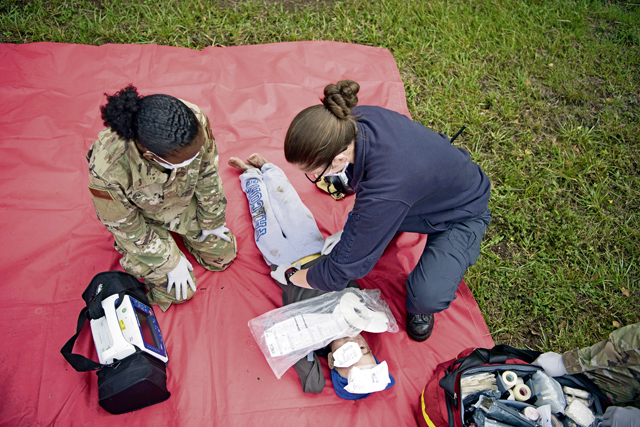
U.S. Air Force Staff Sgt. Julia Racette, right, United States Air Forces in Europe Emergency Medical Services medic, administers lifesaving care to a survivor following a simulated aircraft crash during Operation Varsity 2020-03 at Ramstein Air Base, Germany, Sept. 1, 2020. Within moments of finding the individual, Racette checked airway breathing, circulation and ensured the victims tourniquet remained tight. (U.S. Air Force photo by Senior Airman Kristof J. Rixmann)
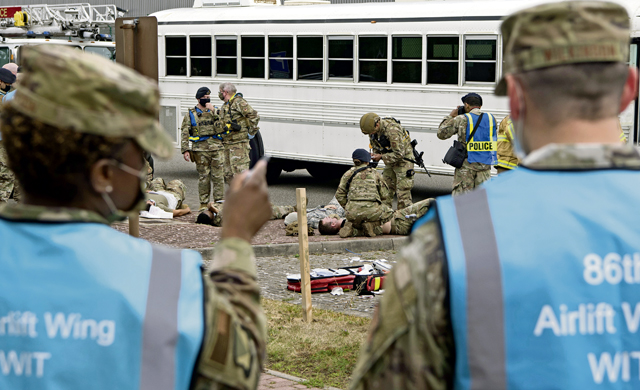
U.S. Air Force Senior Master Sgt. Camille Horton, left, 86th Medical Group quality and compliance superintendent, speaks with 1st Lt. Daniel Wilkinson, 86th MDG bioenvironmental engineer, while a Facility Response Team treats injured victims after a simulated major traffic accident at Ramstein Air Base, Germany, Sept. 1, 2020. The FRT’s responsibility lies in providing the simulated injured victims with efficient, potentially lifesaving medical treatment before transporting them to a well-equipped medical facility. (U.S. Air Force photo by Senior Airman Kristof J. Rixmann)
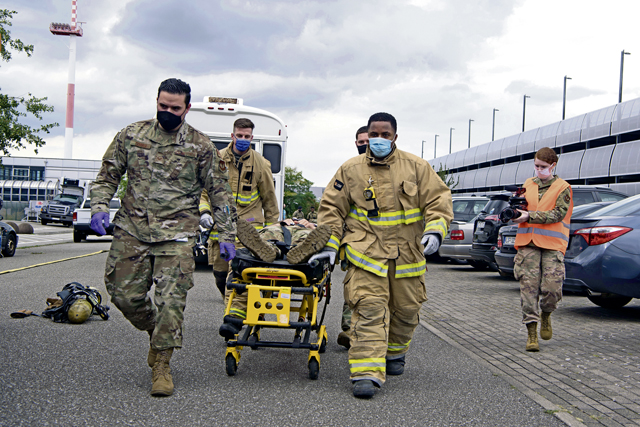
86th Civil Engineer Squadron firefighters and 86th Security Force Squadron members escort an injured victim to an ambulance following a simulated major traffic accident at Ramstein Air Base, Germany, Sept. 1, 2020. First responders tested their ability to efficiently respond while being mindful of COVID-19 regulations and guidelines. (U.S. Air Force photo by Senior Airman Kristof J. Rixmann)
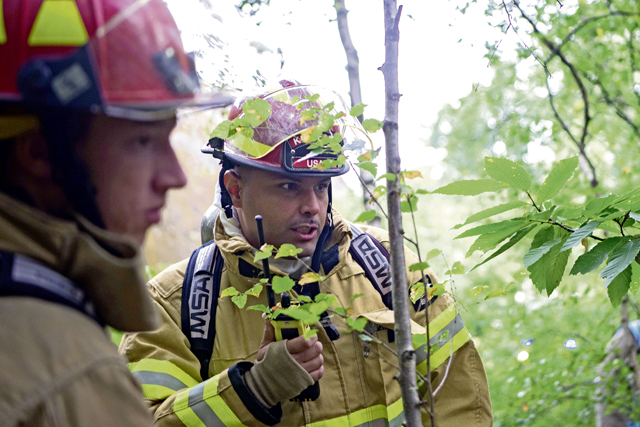
Two firefighters from the 86th Civil Engineer Squadron are the initial first responders to a simulated C-130 Hercules aircraft crash at Ramstein Air Base, Germany, Sept. 1, 2020. Upon arrival, the firefighters encountered a simulated fire, significant aircraft wreckage debris, and wounded individuals. (U.S. Air Force photo by Senior Airman Kristof J. Rixmann)
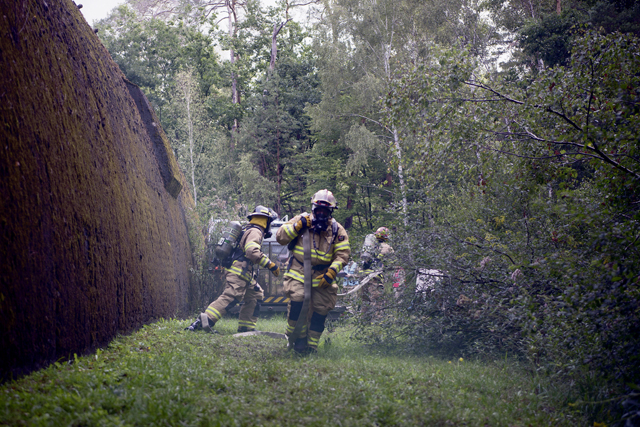
Firefighters assigned to the 86th Civil Engineer Squadron run the fire truck’s water hose to the simulated aircraft crash site during a major accident response exercise at Ramstein Air Base, Germany, Sept. 1, 2020. Putting out fires resulting from an aircraft crash is a top priority as it allows firefighters to quickly move into the site before looking for remaining survivors. This MARE was part of Operation Varsity, a larger exercise which tests the base personnel’s readiness and ability to respond to any situation. (U.S. Air Force photo by Senior Airman Kristof J. Rixmann)
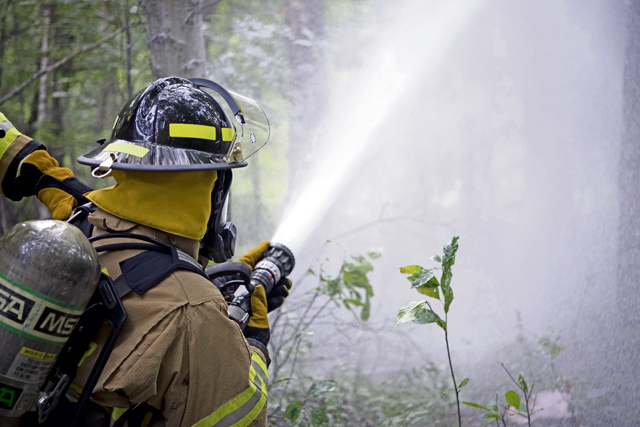
A firefighter from the 86th Civil Engineer Squadron directs water onto the simulated aircraft crash site during a major accident response exercise at Ramstein Air Base, Germany, Sept. 1, 2020. In an exercise environment, firefighters on Ramstein must show capability of the water hose before using it on the simulated aircraft crash. In this case, capability means to demonstrate to Wing Inspection Team members the water hose has sufficient water pressure before being used on the simulated aircraft crash. This MARE was part of Operation Varsity, a larger exercise which tests the base personnel’s readiness and ability to respond to any situation. (U.S. Air Force photo by Senior Airman Kristof J. Rixmann)
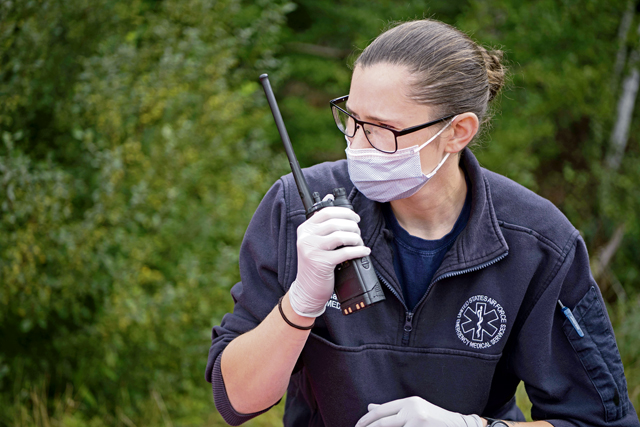
U.S. Air Force Staff Sgt. Julia Racette, United States Air Forces in Europe Emergency Medical Services medic, radios in the critical condition of a survivor following the simulated aircraft crash on Ramstein Air Base, Germany, Sept. 1, 2020. Within moments of finding the individual, Racette checked airway breathing, circulation and ensured the victims tourniquet remained tight. (U.S. Air Force photo by Senior Airman Kristof J. Rixmann)

U.S. Air Force Staff Sgt. Julia Racette, right, United States Air Forces in Europe Emergency Medical Services medic, administers lifesaving care to a survivor following a simulated aircraft crash during Operation Varsity 2020-03 at Ramstein Air Base, Germany, Sept. 1, 2020. Within moments of finding the individual, Racette checked airway breathing, circulation and ensured the victims tourniquet remained tight. (U.S. Air Force photo by Senior Airman Kristof J. Rixmann)

U.S. Air Force Senior Master Sgt. Camille Horton, left, 86th Medical Group quality and compliance superintendent, speaks with 1st Lt. Daniel Wilkinson, 86th MDG bioenvironmental engineer, while a Facility Response Team treats injured victims after a simulated major traffic accident at Ramstein Air Base, Germany, Sept. 1, 2020. The FRT’s responsibility lies in providing the simulated injured victims with efficient, potentially lifesaving medical treatment before transporting them to a well-equipped medical facility. (U.S. Air Force photo by Senior Airman Kristof J. Rixmann)

86th Civil Engineer Squadron firefighters and 86th Security Force Squadron members escort an injured victim to an ambulance following a simulated major traffic accident at Ramstein Air Base, Germany, Sept. 1, 2020. First responders tested their ability to efficiently respond while being mindful of COVID-19 regulations and guidelines. (U.S. Air Force photo by Senior Airman Kristof J. Rixmann)

Two firefighters from the 86th Civil Engineer Squadron are the initial first responders to a simulated C-130 Hercules aircraft crash at Ramstein Air Base, Germany, Sept. 1, 2020. Upon arrival, the firefighters encountered a simulated fire, significant aircraft wreckage debris, and wounded individuals. (U.S. Air Force photo by Senior Airman Kristof J. Rixmann)

Firefighters assigned to the 86th Civil Engineer Squadron run the fire truck’s water hose to the simulated aircraft crash site during a major accident response exercise at Ramstein Air Base, Germany, Sept. 1, 2020. Putting out fires resulting from an aircraft crash is a top priority as it allows firefighters to quickly move into the site before looking for remaining survivors. This MARE was part of Operation Varsity, a larger exercise which tests the base personnel’s readiness and ability to respond to any situation. (U.S. Air Force photo by Senior Airman Kristof J. Rixmann)

A firefighter from the 86th Civil Engineer Squadron directs water onto the simulated aircraft crash site during a major accident response exercise at Ramstein Air Base, Germany, Sept. 1, 2020. In an exercise environment, firefighters on Ramstein must show capability of the water hose before using it on the simulated aircraft crash. In this case, capability means to demonstrate to Wing Inspection Team members the water hose has sufficient water pressure before being used on the simulated aircraft crash. This MARE was part of Operation Varsity, a larger exercise which tests the base personnel’s readiness and ability to respond to any situation. (U.S. Air Force photo by Senior Airman Kristof J. Rixmann)

U.S. Air Force Staff Sgt. Julia Racette, United States Air Forces in Europe Emergency Medical Services medic, radios in the critical condition of a survivor following the simulated aircraft crash on Ramstein Air Base, Germany, Sept. 1, 2020. Within moments of finding the individual, Racette checked airway breathing, circulation and ensured the victims tourniquet remained tight. (U.S. Air Force photo by Senior Airman Kristof J. Rixmann)

U.S. Air Force Staff Sgt. Julia Racette, right, United States Air Forces in Europe Emergency Medical Services medic, administers lifesaving care to a survivor following a simulated aircraft crash during Operation Varsity 2020-03 at Ramstein Air Base, Germany, Sept. 1, 2020. Within moments of finding the individual, Racette checked airway breathing, circulation and ensured the victims tourniquet remained tight. (U.S. Air Force photo by Senior Airman Kristof J. Rixmann)

U.S. Air Force Senior Master Sgt. Camille Horton, left, 86th Medical Group quality and compliance superintendent, speaks with 1st Lt. Daniel Wilkinson, 86th MDG bioenvironmental engineer, while a Facility Response Team treats injured victims after a simulated major traffic accident at Ramstein Air Base, Germany, Sept. 1, 2020. The FRT’s responsibility lies in providing the simulated injured victims with efficient, potentially lifesaving medical treatment before transporting them to a well-equipped medical facility. (U.S. Air Force photo by Senior Airman Kristof J. Rixmann)
(Visited 133 times, 1 visits today)


